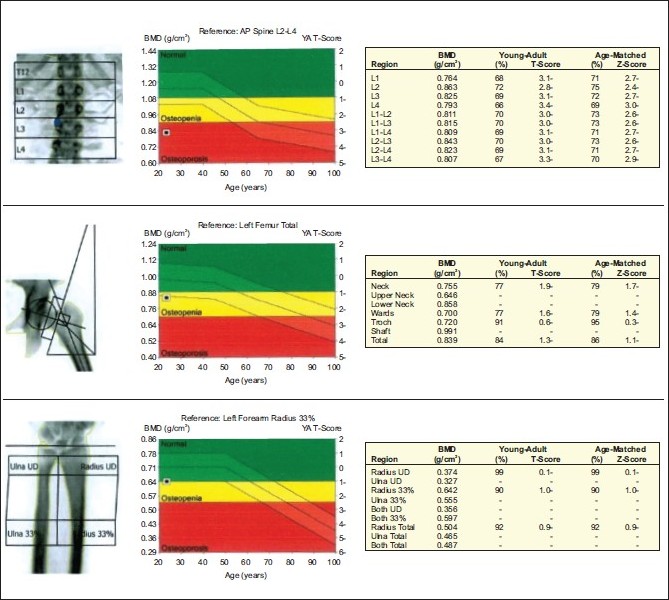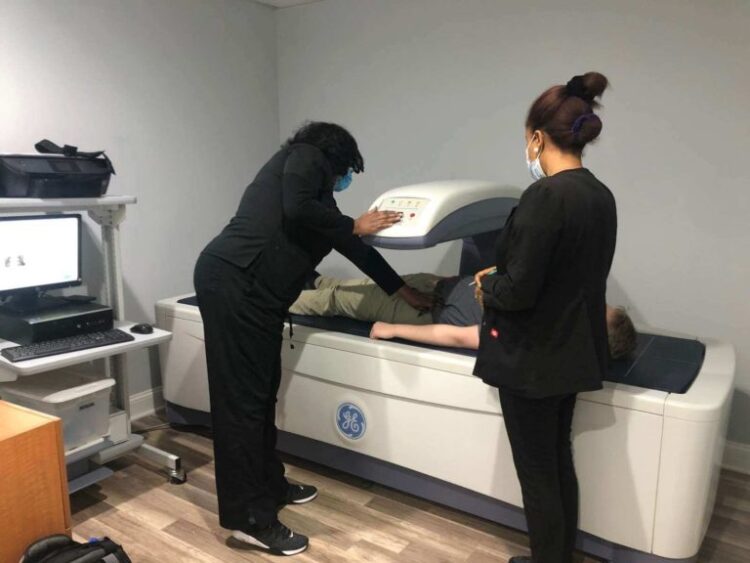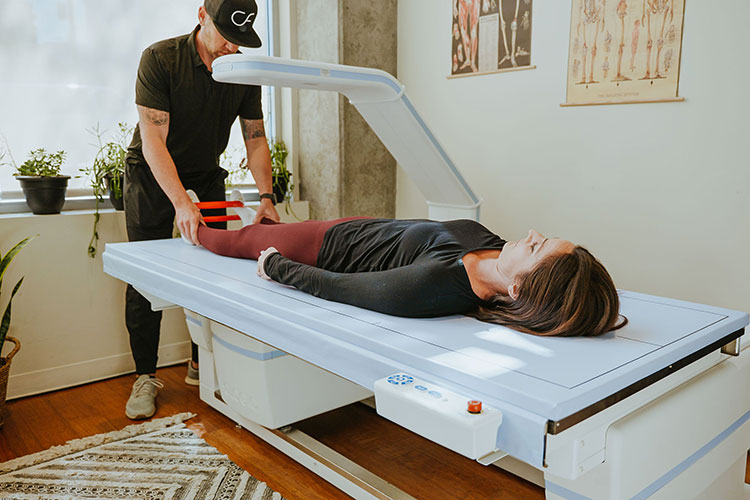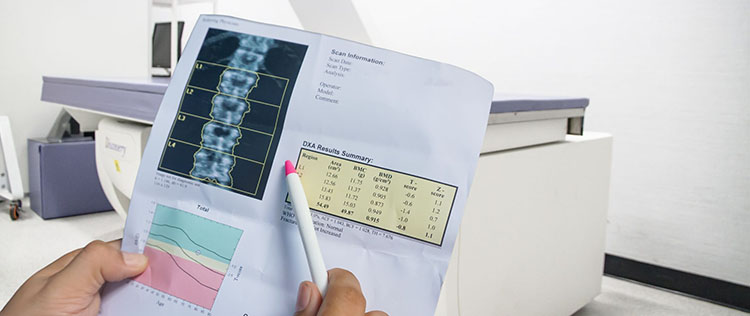A DEXA scan is a painless and quick procedure that can offer a lot of information about your body composition. If you’re looking to get fit or lose weight, a DEXA scan can help you develop a plan. The scan can also be used to diagnose osteoporosis. Below we’ll cover, where to find a scanning location, the risks, costs, preparation, and other FAQs. I’ll also share my experience with the place I go for a DEXA scan near me.
Map of DEXA Scan Near Me
For “DEXA Scan Near Me”, see the map below…
What is a DEXA Scan?
DEXA stands for dual-energy X-ray absorptiometry. It is an accurate painless, noninvasive, scan of your body.
They are used primarily to conduct two types of tests: bone density and measuring fat and lean muscle percentages in your body. As you continue treatment, the procidure is used to measure your body’s response.
DEXA Scan For Bone Density
The scan is a test that uses x-rays to measure the mineral density of your bones. This test is used to diagnose osteoporosis, which is a silent disease that causes your bones to become weak and brittle. DEXA scans are also used to monitor the effects of treatments for osteo and check overall bone health.
DEXA Scan For Measuring Body Fat
DEXA body composition scans can measure your body composition, which is the amount of visceral fat, lean tissue of muscle, and bone in your body. This information can be used to help you lose weight, gain muscle, or both. These are primarily used by fitness enthusiasts and athletes to measure the effects of their workout program.
What Are the Risk Factors of a DEXA Scan?
DEXA scans are generally considered safe. However, as with any medical procedure, there are some risks associated with them.
These risks include:
- Lite Radiation Exposure: DEXA scans use very low levels of ionizing radiation. This type of radiation has the potential to damage cells and DNA. However, the risk of this happening from a DEXA is extremely low. The average amount of radiation you are exposed to is about (0.004–0.005 mSv.) the equivalent of the same radiation you would get flying from Boston to New York on an airplane.
- Pregnancy: DEXA scans use x-rays, which can be harmful to a developing fetus. If you are pregnant or think you may be pregnant, tell your doctor before having one done.
DEXA scans are considered safe for most people. However, it is important to talk to your doctor about any risks associated with the procedure.
How Often Should I Get a DEXA Scan?
If you have osteoporosis, you should have a DEXA scan every one to two years. If you are being treated for osteo, your doctor may recommend more frequent scans to monitor the effects of the treatment.
For those interested in measuring your body fat or muscle, you can schedule one whenever you want. However, it is important to note that these numbers can fluctuate based on your diet and exercise habits. Therefore, if you are tracking your progress, you should have DEXA scans at regular intervals such as once every three months to get the most accurate picture and track your progress.
How is a DEXA Scan Near Me Performed?
Before the Scan
A technician may ask you for or to confirm some basic information. This includes age, height, and weight. They may also inquire if you have had services at the same facility before, this is to ensure that they have your data from the past so that results can be compared over time.
Scanning Procedure
This is a quick and painless procedure. You will lie on your back on a padded table. The arm of the machine, which is large and rectangular, will slowly pass over you, taking scans at small intervals.
The machine will take pictures and the computer program is making calculations about the information while the scanner passes each area.
You must lie still on the table until the scanning arm has passed over your entire body. You will keep your legs still and straight. Your arms will be still and straight with your hands open facing with your thumbs up.
In a bone density scan, they may only do one area such as your hips. They may even place a foam object under your knees to raise them.
A body composition scan consists of scanning the full body head to toe. The entire procedure takes about 10-15 minutes.
After the Scan
Once the arm is done scanning, the technician will let you know that you can move freely. You can put back on any items you needed to remove such as footwear or eyewear. Then you can wait for your printout of the results.
After, you will be able to return to your normal activities immediately. There is no recovery time or special care needed after the procedure. Your doctor will review the results and discuss any next steps with you if necessary.
How Quickly Do You Get the Results?
The results of your DEXA scan are available immediately. Your doctor will review the results with you and discuss any next steps that may be necessary. In most cases, you will hear back from your doctor within 24-48 hours for their interpretation of the data. However, most facilities will give you a printout of the results and you can see them yourself.
For a body fat scan, you will get a printout right away. You can look at the results and make comparisons against your baseline if you have had a scan at the same facility in the past.
Reading the Results
If this is your first time, it will be a baseline and have no comparative data points. If you have had more than one scan at the same facility, you will be able to see how your data points trend over time.

For Bone Density Scans
This scan results in a T-score, which is generated by comparing the patient’s scan with that of a healthy young adult of the same gender.
The World Health Organization (WHO) claims that:
- A T-score of -1.0 or higher is normal bone density.
- A T-score of -1.1 to -2.4 indicates osteopenia or low bone density.
- A T-score of -2.5 or lower indicates osteoporosis.
A DEXA scan may also provide a Z-score, which displays the amount of bone a person has as others of the same size, age, and sex. It can help determine if an abnormal condition is a reason for bone loss.
A Z-score over -2.0 is considered normal by the International Society for Clinical Densitometry (ISCD). A score below this number means that a person’s density is lower than average for their age group.

What is Bone Mineral Density?
Bone Mineral Density (BMD) is a measure of the amount of minerals, primarily calcium and phosphorus, present in a specific area of bone. It is an important indicator of bone health and is used to diagnose conditions such as osteoporosis, which is characterized by low BMD and an increased risk of fractures.
BMD can be assessed through a variety of techniques, including dual-energy X-ray absorptiometry (DXA), quantitative computed tomography (QCT), and peripheral quantitative computed tomography (pQCT). These methods use different types of radiation to measure BMD at specific sites in the body, such as the hip or spine.
In addition to diagnosing osteo, BMD can also be used to monitor the effectiveness of treatment for the condition. It can also be used to assess fracture risk in individuals with other conditions, such as chronic kidney disease or rheumatoid arthritis.
For Body Fat and Lean Mass Scan Results for Body Composition
A person’s body composition (% of lean mass, % fat mass, % of tissue, % of total mass), as well as their Resting Metabolic Rate (RMR), Body Mass Index (BMI), Skeletal Muscle Index (RSMI), are output from the test.
The DEXA body composition results will show how the body mass is distributed in the arms, legs, trunk, android, and gynoid regions. It will even show the differences in the number of lbs of visceral fat and lean mass between your left and right appendages to help you identify muscle imbalances.
How Accurate is a DEXA Scan?
For Bone Density – It’s the Gold Standard
The DEXA scan is known to be the most accurate and precise measurement according to experts. This claim is backed by John Hopkins University.
Regardless, a DEXA scan may not be as beneficial for persons with irregular spine curvature or those who have had spinal surgery, since these circumstances might impact the test’s accuracy.
There are also potential higher error rates for individuals who are exceptionally tall or exceptionally short.
For Body Fat – It’s Considered Accurate
While the DEXA scan for body fat is considered to be accurate, it is not the most accurate body fat test which is Hydrostatic Weighing. Still, the test is very good and is often remarked for its accuracy along with accessibility and convenience.
There are however error rates potentially between 4% and 10%. when used to measure body fat percentage.
How Much Does a DEXA Scan Near Me Cost?
DXA technology is often covered by insurance if they are being used to diagnose or monitor osteoporosis. However, if you are having the scan for other reasons, such as measuring body fat, it may not be covered. The cost of a scan can vary depending on your insurance and the location of the procedure.
Body Fat Scans Are Not Covered by Most Insurance Companies
At the place where I get a DEXA scan near me for body composition, I paid $107 the first time I went and then $87 for each follow-up visit. While my insurance doesn’t cover the DEXA scan I can use the money on my tax-deferred Health Savings Account (HSA) card to cover the costs.
You may find cheaper rates at college universities or gyms that have a scanner. In my research, I found a college that offers scans for $65 on the first scan and $50 for each visit after. For more information on body fat scanning costs, read this.
Preparing for a DEXA Scan Near Me
You do not need to do anything special to prepare, It is similar to going for an X-Ray.
Eat Normal
You can eat normally before and after with no restrictions. Although for body comps, you should ensure you give yourself time to digest before the scan for the most accurate measurement. Food in your stomach could show up as muscle or fat depending on what you ate. You should also avoid eating or drinking anything containing caffeine as this can increase your anxiety and make it difficult to stay still during the scan.
Dress Lite
You should wear comfortable clothing as you will need to remove any baggy clothing like a sweatshirt for the test.
Typically you will need to take off eyewear, footwear, and anything baggy like a sweatshirt.
What Are the Benefits of a DEXA Scan?
There are many benefits to your wellness and health by being able to get valuable information on your body and bones. A DEXA scan is one of the most accurate way to measure body composition and bone density. It can give you a very detailed picture of your muscle mass, fat, and bone mass. This information can help develop fitness or weight loss plan.
If you are interested in tracking your progress, DEXA scans can be very helpful. You can compare your results over time to see how your body composition has changed. This information can be motivating and help you stay on track with your fitness goals.
DEXA scans are also used to diagnose osteoporosis and to monitor the effects of treatment. Osteoporosis is a condition that causes bones to become weak and brittle. This procedure can measure density of the bone and show if there has been any loss of bone mass over time. Your doctor can look at the results and determine a course of action and a treatment plan.
Where to Find a DEXA Scan Near Me
If you are interested in having a DEXA scan, you can find a facility near you that offers the procedure.
Dexa scans are becoming more widely available as the technology becomes more popular. You can usually find a DEXA bone density scan at your local hospital or radiology center. Many chiropractors and primary care physicians also offer the procedure. there are even a few gyms that feature these machines. I have also had luck finding universities that have them and making them available to the public.
The place I go for a DEXA body fat scan near me is an Arthritis and Sports Orthopedics center, but they also have a machine at my local radiology and imaging place.
Booking a Scan
How quickly you can get an appointment for a scan will largely depend on your facility and available locations. At the location I get a DEXA scan near me, I have been able to book with as little as 2 days’ notice. There are however a few times I couldn’t get in right away and needed to wait three weeks.
In my experience folks getting bone scans, typically can get priority. This is because a doctor may indicate to the facility an emergency.
Alternatives to DEXA Scans
Alternative Ways to Measure Bone Density
Though other health tests exist to measure bone density, they are more expensive. The most common and affordable test for diagnosing osteoporosis is a DEXA scan. Here are other options…
- Ultrasound uses sound waves to measure bone density and usually costs $200-$400. There is no radiation exposure in this test. You can find an Ultrasound here.
- Quantitative computed Tomography (QCT) uses X-rays to measure bone density and usually costs $500-$1,000. The radiation exposure is more than a DEXA scan and the output is less accurate.
- Peripheral Quantitative Computed Tomography (pQCT) uses X-rays to measure bone density and usually costs $200-$500. The radiation exposure is more than a DEXA scan and the output is more accurate.
Alternative Ways to Measure Body Fat
If you want to measure your body composition but cannot get a DEXA scan, there are a few alternatives.
- Hydrostatic Weighing: This method uses water displacement to determine your body density. You will be weighed in and out of the water to calculate your body fat percentage. While this method is more accurate than a DEXA scan, it requires you to be undressed and fully submerged in water four to five times. It takes about an hour, but costs less then a DEXA scan. Find a Hydrostatic Weighing test here.
- Skinfold Calipers: This is a method where you will pinch different areas of skin to measure the thickness. The results are then used to estimate your body fat percentage. This method is less accurate than a DEXA scan but can be done at home in just a few minutes. You can get them on Amazon for less than $10.
- Bioelectrical Impedance Analysis (BIA): This method uses a small electrical current to estimate your body fat percentage. The results of these app-based BIA tests are not as accurate as a DEXA scan but can give you a general idea of your body fat levels. You can find a scale with BIA technology on Amazon starting at around $50.
DEXA Scan Near Me – Conclusion
A DEXA scan is a safe and painless procedure that can give you a very detailed picture of the wellness of muscle mass, fat, and bone mass health. This information can help develop a fitness or weight loss plan or assist a doctor in identifying Osteoporosis. DEXA scans are becoming more widely available as the technology becomes more affordable. That’s what I have learned from the place I go for a DEXA scan near me.





